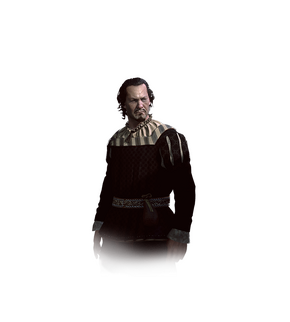| Higher vampires | |
|---|---|

| |
| Details | |
Class |
Vampires |
Immunity |
Fire Silver[1] Daylight Holy water Crucifixes Garlic |
Susceptibility |
Vampire oils Igni |
Higher vampires are post-Conjunction creatures that often resemble humans. Under the "higher vampire" umbrella of vampiric species, they are a separate and extremely powerful breed. Such vampires exhibit supernatural powers, invulnerability to sunlight, strong regenerative capabilities and a complete mastery of camouflage.
According to Regis, there are three tribes of higher vampires that arrived on the Continent during Conjunction of the Spheres: Gharasham, Ammurun and Tdet. Gharasham remained in the west, Tdet traveled east, beyond the Blue Mountains and Ammurun ventured beyond the sea.
Notable higher vampires
- Emiel Regis Rohellec Terzieff-Godefroy
- Dettlaff van der Eretein
- Orianna
- Hubert Rejk
- The Unseen Elder
In The Witcher 3: Wild Hunt
Bestiary entry
- Men, the polite ones, at least, would call me a monster. A blood-drinking freak.
- — Emiel Regis, high vampire
- Only a mutual thrist for blood links higher vampires to their distant and much more primitive cousins: ekimmaras, alps, katakans and the like. Higher vampires are, in fact, much more similar to humans than to those bat-like blood slurpers. They not only resemble us in appearance, but also share our intelligence and behavioural patterns. This means they do not squat in distant forest or hide in the shadows. On the contrary, they are particularly fond of cities, where they live out deceivingly normal lives. Even witchers are not capable of recognizing them at once, for their medallions remain perfectly motionless in the presence of higher vampires. Yet all these similarities should not blind us to an essential difference: unlike men, higher vampires are immortal. Those who have faced them in combat and survived can be counted on one hand.
- It is a witcher's good fortune that higher vampires are extremely rare — and not all are dangerous to humans. Though they do have a taste for blood, they do not need to drink it to survive. Some higher vampires have renounced feeding on humans altogether and do no harm to anyone, but others give in to their desires. A witcher who braves fighting a higher vampire must bear in mind that he faces a monster endowed with incredible strength, one able to manipulate men and animals, turn invisible and transform into a giant bat – and furthermore one which it is nearly impossible to kill. In other words, even an experienced monster slayer should think twice before accepting a contract on one of these creatures, even if half a kingdom and a princess' hand is in the offing.
In other sources
Many experts include alps, mulas, katakans, bruxae, and nekurats as members of this group. These species indeed possess several unique traits not shared by their lesser cousins, and thus are commonly called higher vampires. They are resistant to sunlight and most can mask their true natures and pretend to be human, which aids them in hunting or evading pursuit. Many are also capable of transformation and possess telepathic powers, making them formidable foes. Despite all these abilities, however, they are not true higher vampires.
Genuine higher vampires are a separate, extremely powerful breed, commanding great powers are sometimes unique to particular specimens. They are masters of the art of camouflage and in most cases appear nearly identical to humans. Only their their teeth, and the fact that they cast no shadows and have no reflections in mirrors, can reveal their true nature. I have even met one higher vampire whose presence did not trigger a reaction from my witcher medallion. Besides being supernaturally fast and agile, higher vampires can also assume the form of a giant bat, become invisible, and use their gaze to mesmerize their victims or put them to sleep. They are invulnerable to sunlight, fire, and silver, and have unbelievable regenerative powers which allow them to return to life even after beheading, dismemberment, or incineration- though in such cases the process may take many decades.
References
- ↑ In the novels only
